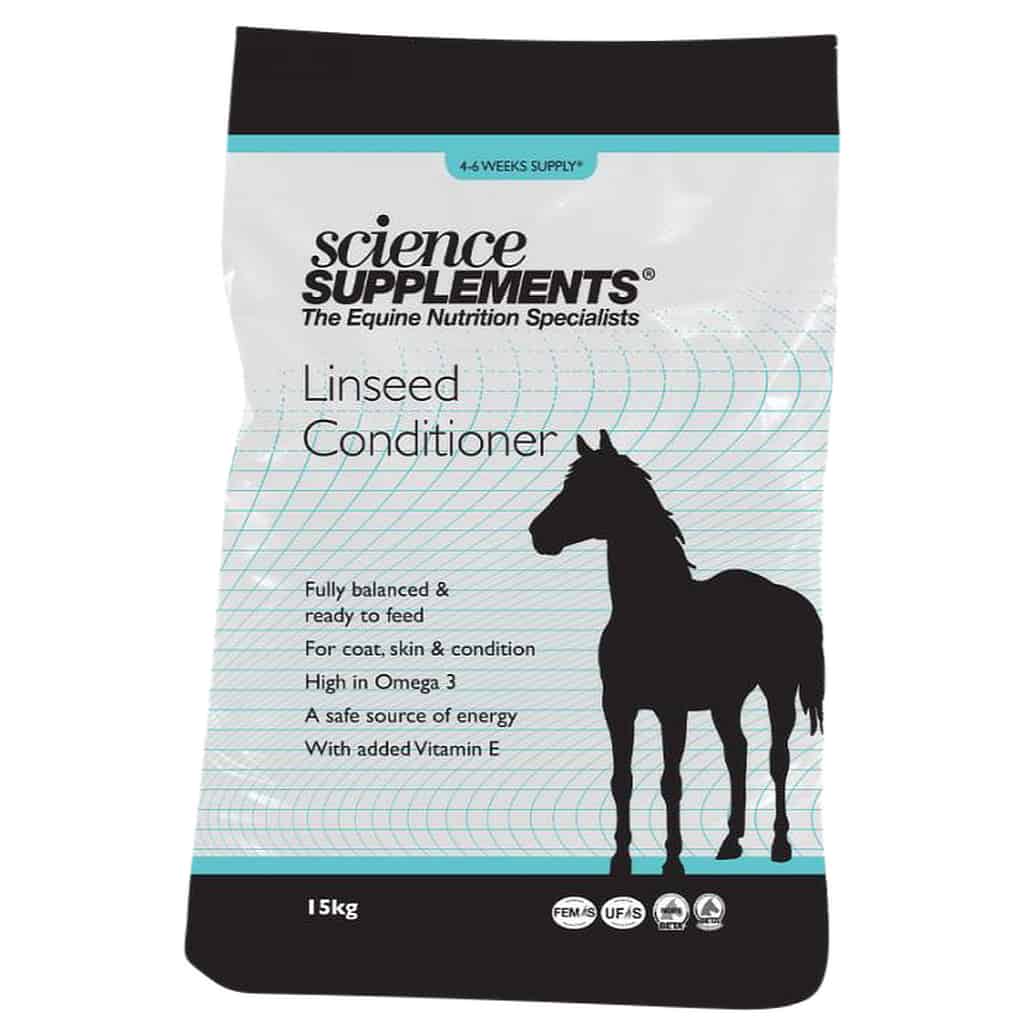The benefits of feeding linseed to horses have been appreciated for years. But it has not always been the most practical feed due to a lengthy preparation time of boiling before use.New technology now allows us to feed straight from the bucket.
Science Supplements Linseed Conditioner is a pure Linseed product, not to be confused with other products on the market which may only contain as little as 33% linseed because they are mixed with cheaper sources of oil.
Linseed Conditioner has been micronised (cooked) and comes as a palatable meal ready to feed.
Linseed Conditioner is high in oil and very low in starch thus providing a 'safer' energy source compared to cereal feeds.
Linseed Conditioner maintains healthy skin condition and produces a show ring shine effortlessly. This is due to the high concentration of omega 3 fatty acids found in linseed oil, unlike that of soya or corn oil. Scientific Research has reported the benefits of linseed for horses and the high level of omega 3 fatty acids helps to maintain skin health.
Ordinary linseed is low in calcium and has an unfavourable calcium to phosphorus ratio. Linseed Conditioner has been fortified with calcium to redress this balance helping to maintain normal skeletal, nerve and muscle function.
Scientific Research has proven that horses require extra vitamin E when fed diets supplemented with oil. Linseed Conditioner has been fortified with generous levels of vitamin E to satisfy this increased requirement.
In what form does linseed conditioner come?
Linseed Conditioner comes in the form of a meal that looks similar to bran.
How do I feed Linseed Conditioner?
Linseed Conditioner is very palatable and so can simply be added to your existing feed daily.
Doesn't linseed need to be boiled before feeding?
Linseed is a very traditional feed that has been fed for very many years. However, up until recently linseed needed to be boiled before feeding to destroy some undesirable substances similarly to soya.
Linseed Conditioner uses modern micronising technology to pre-cook the linseed at very high temperatures so that it can be fed straight from the bucket with no need for soaking or boiling.
How much Linseed Conditioner should I feed per day?
The amount of Linseed Conditioner that you feed per day will depend on your individual horse or pony, its bodyweight and level of exercise.
As a guide, we recommend between 125 - 500g per day for a pony (this is roughly equivalent to 1/2 - 2 mugs full per day). For a horse we suggest between 250 - 1000g per day (this is roughly equivalent to 1 - 4 mugs full per day).It is important to always feed to maintain a suitable body weight and condition.
Linseed Conditioner is very high in protein (22%) is this ok?
Linseed Conditioner contains 22% protein. This means that for every 100g fed it provides 22g of protein. Even when Linseed Conditioner is fed at the maximum recommended level for a horse, for example, it will still only provide 220g of protein, which is about 20% of the daily requirement for a horse in work. So as you can see the percentage protein content of a feed is only relevant when looked at together with the level of the feed fed daily.
How much oil does Linseed Conditioner provide?
Linseed Conditioner provides about 34% oil. This means that for every 100g fed 34g will be oil. For example, a horse fed 500g of Linseed Conditioner will gain an additional 170g of oil. Supplementing an endurance horses' diet with oil is reported to be beneficial to help maintain condition, but also to allow efficient use of 'fuel' during exercise.
Do I need to feed any additional vitamin E or calcium with Linseed Conditioner?
It is recommended that horses being fed an oil- supplemented diet be fed additional vitamin E (antioxidant). Linseed Conditioner however already provides the recommended additional vitamin E required in a bioavailable form. Ordinary linseed has very low calcium to phosphorus ratio and ideally should be fed with additional calcium. Science Supplements have balanced the calcium to phosphorus ratio in Linseed Conditioner and so there is no need for additional calcium.
Why are omega 3 fatty acids important?
Omega 3 fatty acids are essential fatty acids that need to be fed as part of the diet as they cannot be synthesised by your horse. They are only found in very low amounts in popular oils such as corn and soya oil. These latter oils are the ones most commonly added to a horses' ration either by horse owners or by horse feed manufacturers. In contrast, Linseed Conditioner is a very rich source of omega 3 fatty acids. Omega 3 fatty acids are important to help maintain coat and skin condition, to maintain immune function and to aid repair processes.
Will Linseed Conditioner make my horse excitable?
Linseed Conditioner is very efficient at both promoting weight and condition in underweight horses and ponies or helping to maintain condition in those training and competing regularly. However, because Linseed Conditioner is low in starch and high in fibre and oil (slow release energy), it is less likely to cause excitability than some other cereal containing feeds.
Is linseed conditioner suitable for ponies prone to laminitis?
Linseed is very low in starch and simple sugars and is high in easily digestible fibre. It is therefore a suitable feed for ponies that are prone to Laminitis. However, as many ponies at risk of laminitis are prone to weight gain, care should be taken not to overfeed and a suitable bodyweight should be maintained at all times.


